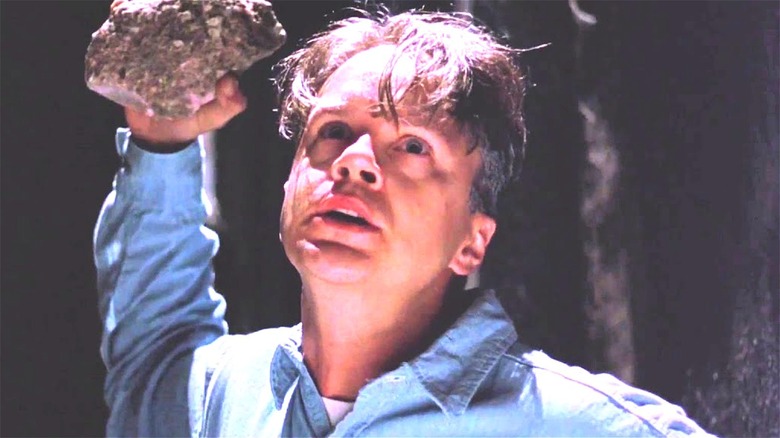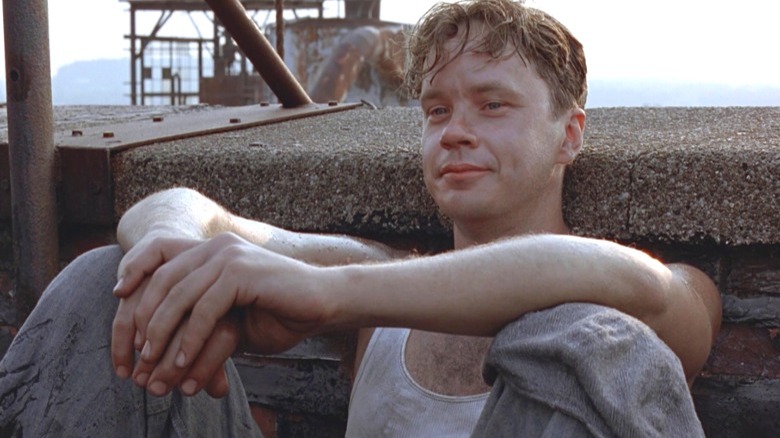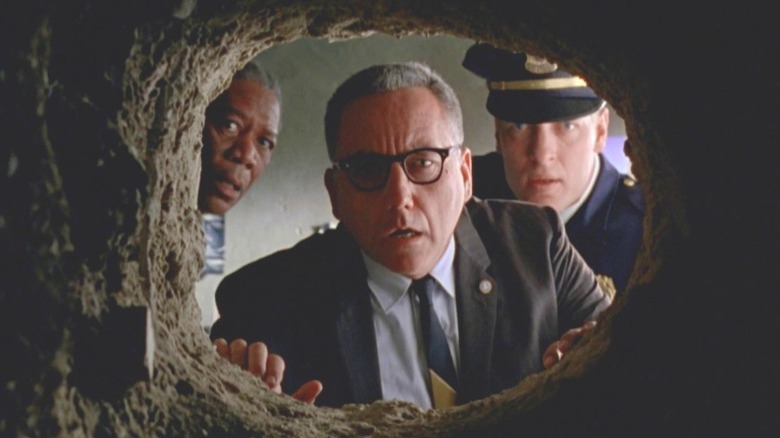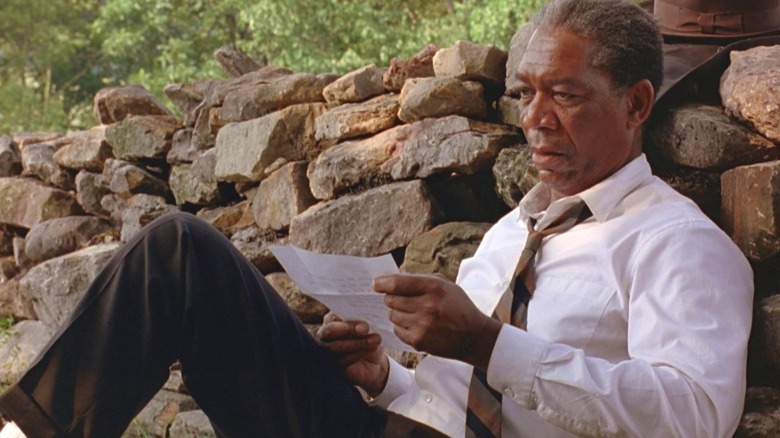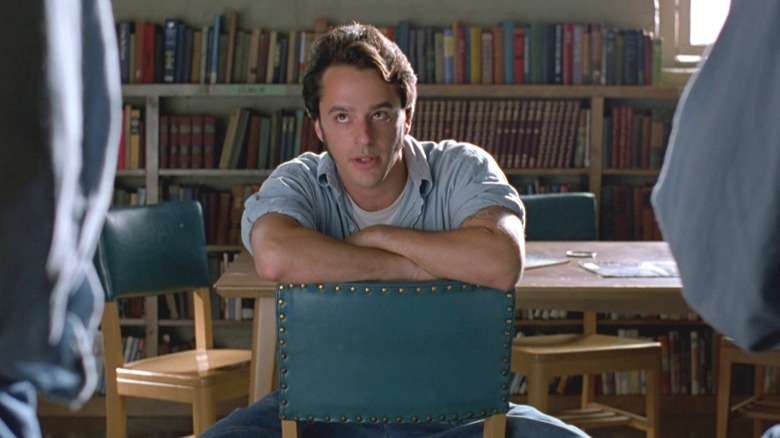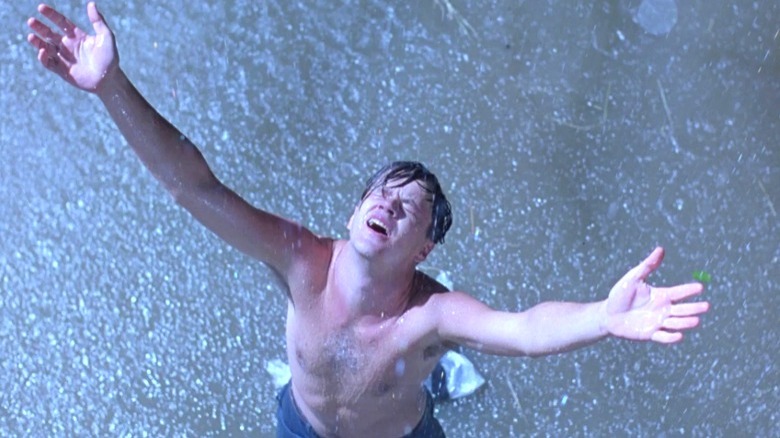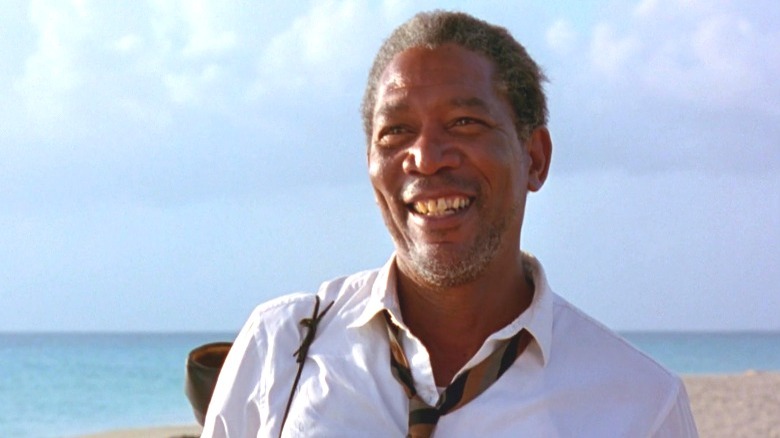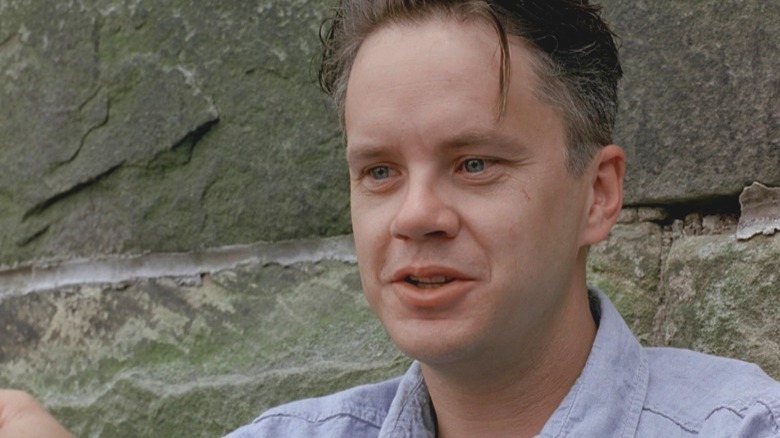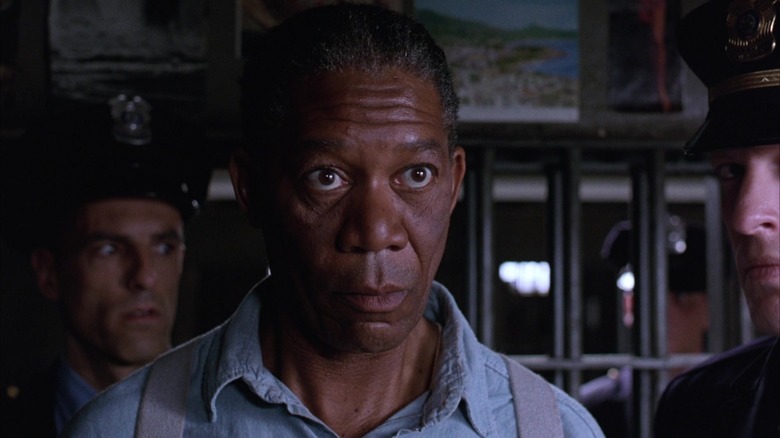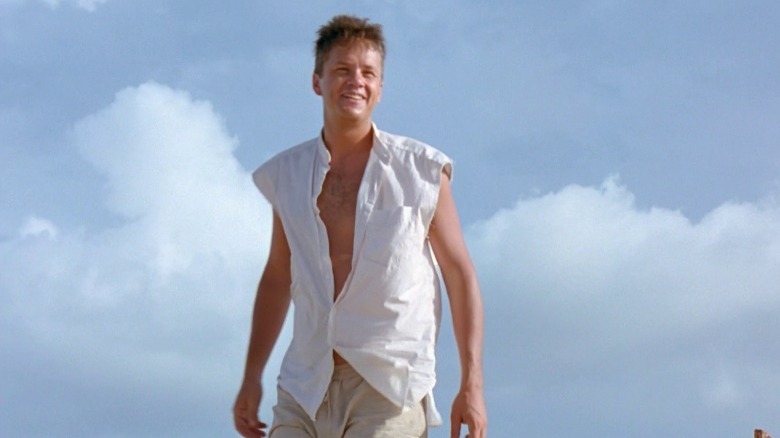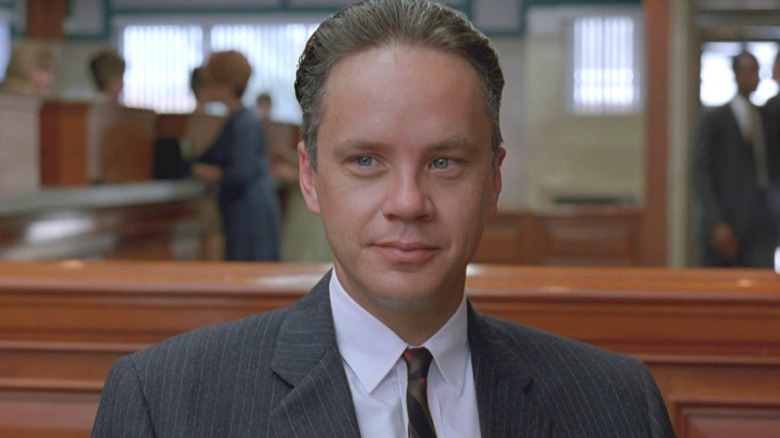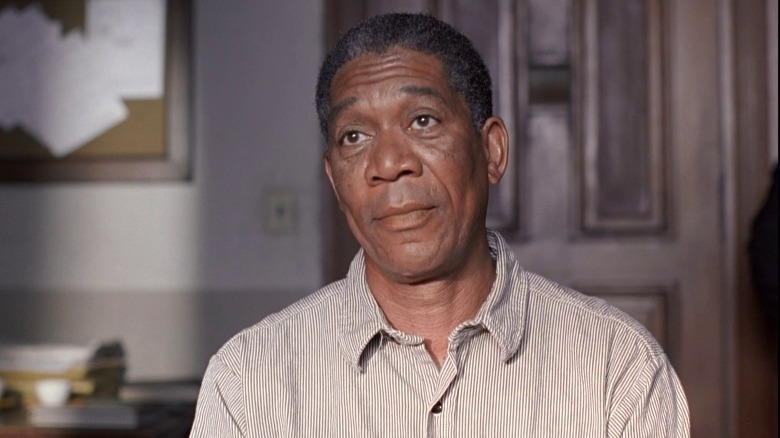The Ending Of The Shawshank Redemption Explained
While it might not have been the most successful movie upon its initial release in 1994, in the years since, "The Shawshank Redemption" has become one of the most celebrated Hollywood prison dramas. Frank Darabont directed the film, based on the Stephen King novella "Rita Hayworth and Shawshank Redemption." The movie stars Tim Robbins as Andy Dufresne, Morgan Freeman as Ellis Boyd "Red" Redding, and William Sadler as Heywood, as well as many others including James Whitmore and Clancy Brown.
Set in the years following the end of the Second World War, the movie explores the depravity and dehumanization that goes on behind prison walls, as well as the toll it takes on both inmates and guards alike. For many people, the best part of the movie is its ending. After years apart following Andy's escape from prison, he and Red are finally reunited in Mexico and share a warm embrace as the camera pans away.
Yet the ending is also not without some ambiguity, as we never find out how Andy and Red actually live out their remaining days. From the question of how Andy may have gotten away with his escape to how Robbins, Freeman, and Darabont feel about the fates of the main characters, this is the ending of "The Shawshank Redemption," explained.
What you need to remember about the plot of The Shawshank Redemption
Set in the 1940s through the 1970s, "The Shawshank Redemption" tells the story of Andy Dufresne, a man falsely convicted for the double murder of his wife (Renee Blaine) and her lover (Scott Mann). He is incarcerated at the Shawshank Prison in New England, but prior to his imprisonment, he was a successful banker and a law-abiding citizen. After entering prison, Andy meets Ellis Boyd "Red" Reddington, one of the most respected men in Shawshank, and the two eventually become lifelong friends.
Andy's early years in prison are marred by constant violence, as he becomes the target of "the Sisters" — a group of vicious inmates who go around assaulting weaker convicts. However, Andy soon gains the trust of Warden Samuel Norton (Bob Gunton) and the top guard, Capt. Byron Hadley (Clancy Brown), and they begin protecting him from the inmates' violent assaults. Eventually, Andy starts using his expertise as a former banker to help the guards at Shawshank with their taxes, and he also starts laundering money for the warden.
All the while, Andy is continually raising funds to build a prison library, which he uses to help educate the other inmates. However, after 19 years in Shawshank, Andy's attitude starts to change, and he cryptically makes Red promise to visit a spot in Buxton, Maine, if he ever gets released. There, Andy tells him, is something he had buried many years ago and wants Red to retrieve.
What happened at the end of The Shawshank Redemption
After Andy Dufresne and Ellis Boyd "Red" Reddington have their cryptic conversation, Red learns that Andy had asked another inmate for 6 feet of rope. The next morning, Red is dismayed when Andy does not come out of his cell, but things quickly change.
Instead of being dead, Andy is missing entirely — seemingly gone without a trace. After going on an angry tirade in Andy's cell, the warden realizes the existence of a secret tunnel that Andy had dug through the wall. Attempts to capture him are fruitless, and Andy is able to steal much of the money he had laundered for the warden. He also submits evidence of both the warden and the guards' illegal activities at Shawshank, which leads to several arrests and the warden's death by suicide.
Years after Andy's escape, Red is finally granted parole after four decades behind bars. Struggling to adapt to the outside and bitter over his time in prison, the only thing that keeps Red going is the thought of traveling to Buxton to retrieve Andy's mysterious package. Red finally makes it to Buxton, where he finds a case filled with money asking him to join Andy in Zihuatanejo, Mexico. Red breaks his parole and illegally leaves the state, where he reunites with Andy on the beach, finally full of hope.
If you or anyone you know is having suicidal thoughts, please call the National Suicide Prevention Lifeline by dialing 988 or by calling 1-800-273-TALK (8255).
The movie was all about friendship
In the final moments of the film, when Andy Dufresne and Ellis Boyd "Red" Reddington finally see each other again on the beach of Zihuatanejo, Mexico, it becomes clear that the true meaning of "The Shawshank Redemption" is about friendship. Andy and Red are true friends who have an intrinsic bond that formed during their many years together in prison. Though they came up living very different lives, Andy being a hotshot banker and Red being incarcerated from a very early age, they are still able to connect on a soulful level.
Some people might question why Andy would keep Red in the dark about his escape plans if they were such good friends, because it's not like he lacked trust in Red's ability to keep a secret. For a time, Red thinks that he might have been dead, and the only confirmation he has that Andy is alive is a blank postcard sent from near the Mexican border.
Andy likely kept Red in the dark because he knew that it would be his only chance to escape, and he potentially wanted to save Red from trying to join him and end up risking his parole. In the end, it was the power of friendship that makes Red travel from New England all the way to Mexico based on a single note and a long-ago conversation. He is rewarded for his loyalty, and his friendship with Andy finally brings him true happiness.
Andy's library was the key
Throughout "The Shawshank Redemption," Andy Dufresne is constantly creating and building his library, the "Brooks Hatlen Memorial Library." When he first arrives at Shawshank in the late-1940s, the library is limited to basically just one room full of magazines and a few books. Brooks Hatlen (James Whitmore) runs the library for several years until Andy becomes his part-time assistant.
Andy sees the poor nature of the library, and he begins writing weekly letters to his local congressmen to try and procure funds to rebuild it. After getting $200 and a few boxes of books, Andy ups his letters to bi-weekly, which prompts the state legislature to eventually give him real funding to create and maintain his library. While Andy uses the library to help educate the other inmates, including helping some get their GEDs, it also ultimately serves a much more important purpose as the catalyst for Andy's escape.
While running the library, Andy comes into contact with a new inmate, Tommy Williams (Gil Bellows), who eventually helps Andy realize the identity of his wife's true killer. Andy tries to take this up with the warden, who has Tommy killed so that the truth can never be found out. This finally convinces Andy to make his escape from Shawshank, so he can take the warden's laundered money and finally expose him for his crimes. Without the library, Andy would have never learned the truth about his case — if he hadn't, he might never have escaped Shawshank.
Could Shawshank really be about religion?
While some see the ending of "The Shawshank Redemption" as being relatively straightforward, others detected immense amounts of symbolism. One incredibly popular theory is that the movie is really an allegory for Christian theology. According to British critic Mark Kermode in his book "The Shawshank Redemption," many see the character of Andy Dufresne as being analogous to that of Jesus Christ.
He faces much abuse in the film, especially during his early years in prison, but manages to never become too injured. After overhearing a chance conversation, he soon receives the explicit protection of the warden and his staff — almost as if he is receiving "spiritual protection." In addition, you could argue that Andy's journey through Shawshank is reminiscent of the resurrection of Jesus. He is subjected to violence from fellow inmates — similar to Jesus being attacked during the Via Dolorosa. While still imprisoned, Andy's final chance at hope for legal escape is eliminated by the warden, and he experiences a spiritual death. He has to crawl through a waste pipe to exit Shawshank, until he finally escapes and is washed clean by the rain. He exits the tunnel and immediately poses in a cross formation under the pouring rain, and this can be interpreted as the rain washing away Andy's sins, allowing him to be resurrected and reborn. It's only after Andy's escape that Red finally makes parole, almost as if his sins have been forgiven.
Is Zihuatanejo a metaphor for heaven?
Similar to how Andy Dufresne can be seen as a metaphor for Jesus Christ, some consider the final destination of Zihuatanejo, Mexico, to be a metaphor for heaven. Andy describes Zihuatanejo as a place that "has no memory," and he says it is where he wants to spend the rest of his life.
Eventually, after his escape from Shawshank, Andy is able to fulfill his dream of living out his life in Zihuatanejo. It's easy to interpret his remark about Zihuatanejo having no memory as being a place where he is absolved of all sin, just like heaven. While Andy is still a wanted man due to his escape from prison and conviction of double murder, in Zihuatanejo he (seemingly) does not have to worry about that. He can live out his life in anonymity, minding his own business and living happily.
Red soon joins Andy in Mexico after his own release from prison. For Red's part, this potentially symbolizes his spiritual death from serving decades in prison, and his subsequent rebirth of being free in the heaven of Zihuatanejo. While the ending is left somewhat ambiguous, as we have no idea what happens to Andy or Red later, it's implied that they are able to find peace in Mexico. In many ways, Zihuatanejo is Andy and Red's heaven, as they both experience spiritual rock bottom in Shawshank, only to find the ultimate peace of salvation and freedom in Mexico.
The film version uses an alternate ending
Many people do not realize it, but Frank Darabont's "The Shawshank Redemption" is actually based on Stephen King's novella, "Rita Hayworth and Shawshank Redemption." For the most part, "The Shawshank Redemption" stays faithful to the book with only a few changes. However, one big exception to that is the ending, which Darabont significantly changed for his theatrical interpretation.
In the book, Andy Dufresne and Ellis Boyd "Red" Reddington both get out of prison the same way as in the movie, with Andy escaping and Red making parole, but they never meet up together in Mexico. Andy tells Red about the spot in Buxton, Maine, where he is supposed to go, and Red goes there and digs up the box that Andy had left. However, the book ends with Red planning on going down to meet Andy in Mexico, but King omits Red's actual journey.
In the movie, of course, Andy and Red meet up on the beach of Zihuatanejo and have a brotherly embrace. It's definitely a much happier and more fulfilling ending in the theatrical version and gives the movie a satisfying close. There is still some question about how Red and Andy will live out the rest of their lives, but at least the audience is able to know that the characters definitely find each other in the end.
Andy must have had help with the Raquel Welch poster
One of the most debated aspects of "The Shawshank Redemption" comes in the scene when the warden discovers the hidden tunnel in Andy Dufresne's cell. After first accusing Ellis Boyd "Red" Reddington and the guards of being involved in a conspiracy, the warden throws one of Andy's rocks at his poster of "that cupcake on the wall," Raquel Welch. However, instead of the rock hitting with a thud and bouncing off, it instead rips through the poster, revealing the existence of a tunnel.
What makes the scene controversial is the poster's initial condition. It would have been practically impossible for Andy to perfectly reattach the poster to the wall from inside the tunnel. The tunnel was not nearly wide enough for him to pin it up and turn around to crawl out, but somehow it was reattached.
Considering that Red was oblivious to the escape attempt, he could not have been Andy's accomplice, leaving only the guards as his logical co-conspirators. As the warden noted, he was marked present by the night watch and they likely helped him out. Andy could have promised to pay them off with the funds he was going to steal from the warden, and some of them likely would have been off-put by the warden's corruption and willing to help. The movie never tells us for sure, but he virtually has to have been helped by the guards.
What Tim Robbins thinks about the ending
In the years since its release, "The Shawshank Redemption" has become one of Tim Robbins' most popular starring roles. The realism and depth that he brings to the character of Andy Dufresne are incredible, and he makes the horrors of prison feel real. Though it's not confirmed that Andy is innocent of the double murders until near the end of the film, Robbins' performance still humanizes him in the eyes of the audience and makes them cheer him on.
In 2019, Robbins gave an interview with Entertainment Weekly, where he gave his personal thoughts on Andy and how he felt about the ending. For Robbins, the movie is both about friendship and hope, which he believes is symbolized by their ending in Zihuatanejo, Mexico. Both Andy and Ellis Boyd "Red" Reddington had to overcome enormous obstacles to survive Shawshank, and it was only through keeping hope and trying to become better people that they were able to find their happy ending in Mexico.
Robbins remarked that Red and Andy's friendship was transcendent of everything, and did not rely on things like car chases or other outside forces to work. Red and Andy truly cared about each other, and their friendship is what ultimately led them to the salvation of Mexico. For Robbins, the essence of the film is Red and Andy's friendship, and the realness that emanates from the film is why audiences have always related so strongly to it.
Frank Darabont on changing the ending
One of the biggest differences between the film version of "The Shawshank Redemption" and the book version is the ending. While the book leaves it ambiguous as to whether or not Ellis Boyd "Red" Redding and Andy Dufresne actually meet up, the film shows them reuniting on a beach in Mexico. In addition, in the book Andy does not rip off the warden and steal his money — he merely escapes. According to an interview that Darabont gave to Creative Screenwriting in 2016, he deliberately made the changes to strengthen Andy's character.
Darabont stated that by tying in the money laundering with Andy's escape, it made the character feel "cleverer" and "provided a payoff to the setup." He felt that not having Andy take advantage of all the schemes to make his escape better — and rely on a character external to the prison, as Stephen King does in his novella — would have been a mistake, and Darabont said he wanted to increase the drama of the movie.
It certainly worked. The ending, of Andy not only scamming the warden out of nearly half a million dollars but also meeting up with Red, provides catharsis at the end of a tough journey. Without the final payoff, the story of Red and Andy feels unfinished, and their final meeting is the perfect closure.
Morgan Freeman on Andy and Red's ending
Of all the roles that Morgan Freeman has played during his long and distinguished career, his turn as Ellis Boyd "Red" Reddington is definitely one of his most memorable. Similar to Tim Robbins portrayal of Andy Dufresne, Freeman brought an uncanny realness and an air of wisdom to the role of Red. Though the movie does not really delve into his backstory as the book does, he still comes off as a sympathetic character who is deserving of justice.
In 2021, 27 years after "The Shawshank Redemption" came out, Freeman (or, more likely, an assistant or agent) acknowledged the movie in a Facebook post, giving some thoughts on how things turned out for Red and Andy at the end of the film. The post says, "I'd like to think Red and Andy are enjoying a simple life in Zihuatanejo, as fishermen on the bay."
